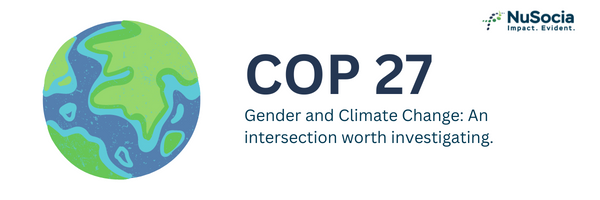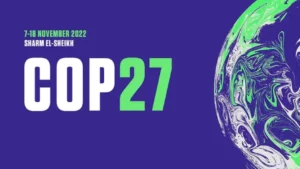Global policy discussions around gender and climate action
Last month, from November 6-18, the global development community was focused on the 27th United Nations Climate Change conference, or shortly known as COP27. An annual conference being organised since the United Nations Climate Agreement, COP27 witnessed the gathering of delegates from 190 countries to discuss the growing climate concerns, the way forward through adaptation and policy formulation and the progress on points from the Kyoto Protocol and the Paris Agreement.
Earlier this year, in March 2022 another United Nations global conference discussed the effects of climate change while maintaining a specific lens. The 66th session of the Commission on the Status of Women saw its 45 member states come together to discuss and address the vital status of women and gender equality in climate change. Here, 62 agreed conclusions were reached under “Achieving gender equality and the empowerment of all women and girls in the context of climate change, environmental and disaster risk reduction policies and programmes”.
Based on this background and the immediate presence of COP27 as an impactful platform, the Executive Director of UN Women, Sima Bahous, wrote an Op-Ed piece penning 3 requests to the COP27.
- She urged the COP27 to first ensure that women and girls have access to equal participation in the decision-making sphere, especially from marginalised groups and the inequalities of resources like land, finance and technology.
- Second request was to integrate gender perspective in the national policies to “support a just transition for women through an alternative development model”
- Third, measures are taken and investments are made to support and develop women and women’s organisations.
National policy discussion around gender and climate action
In the Indian context, COP27 participant Bhupendra Yadav, India’s Union Cabinet Minister for Environment, Forest and Climate Change keenly mentioned a 4-year programme focusing on climate action in agriculture and food security indicating the priority areas for India. Though it does not explicitly mention gender, it addresses the 80% of the rural women involved in agriculture
The intersection of gender and climate change in India
The intersection between Gender and Climate Change is higher in developing economies like India, where women have gendered roles and are the direct receiving end of consequences. To elucidate with an example, in India, rural women have the primary responsibility of collecting water for their households. With climate change, there is a growing scarcity of these basic resources. Gradually, to secure these resources; their exposure to challenges like the increasing temperatures, lack of green cover, increasing proximity to wildlife, increased distance of travel are all consequences they will have to bear. This free labour does not get them any economic or social compensation. Exposure to drastic climate changes such as heat strokes also creates a higher risk to poor maternal health.
In the case of younger girls who have to participate in these tasks to secure a higher amount of resources, the time meant for their education, wellbeing and recreation gets eaten up. In India, a 22% increase in the school dropout rate has been due to the increased distances for water collection .
As the documents and summaries from COP27 and the side events are still emerging, it can be concluded that the importance and inclusion of gender perspective in climate change is being discussed on global levels. Key action points such as addressing the gendered inequalities of climate risks, participation of women and gender perspective in creation of national climate policies and decision-making areas will be critical to “shift the narrative away from women and girls as vulnerable victims and instead promote women’s leadership and participation in all climate action.”.
What can we do about it?
India is a diverse country and the climate change effects we face are just as diverse. From excess rainfall in the north-east to the alarming depletion of freshwater in the west, our issues are quite heterogeneous. As consultants or as intervention designers, a good place to start would be to understand that this is an umbrella issue and can be linked to other popular areas of CSR funding such as education, waste management, water conservation and upskilling. Widening the scope of inquiry to include questions on gender roles and the responsibilities that come with it, female involvement in the workforce can provide a wider perspective. Interventions such as teaching women SHGs to make cloth pads, educating adolescent girls on the proper disposal of sanitary napkins or providing affordable irrigation solutions to farmers can all ease the burden of the relationship girls and women have with climate change.
How can we help?
If you are looking to add a gender lens to your existing climate action interventions, or design a CSR program that includes gender and climate justice, we will be happy to talk! You can reply to this email and we will get in touch with you.
Videos offering more information –
- IPPF, ARROW, DFPA: From CSW66 to COP27: Ensuring accountability for gender-transformative climate action – https://unfccc.int/event/ippf-arrow-dfpa-from-csw66-to-cop27-ensuring-accountability-for-gender-transformative-climate-action
- Disability inclusive actions for a greener future – https://media.un.org/en/asset/k16/k166trjr6u




